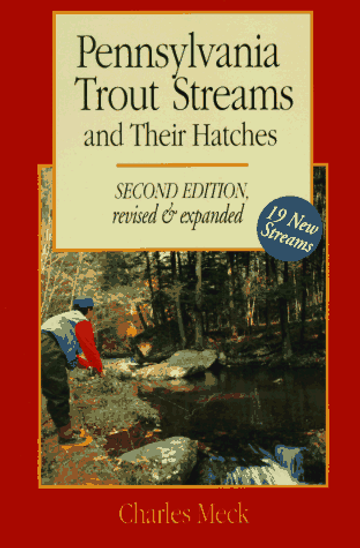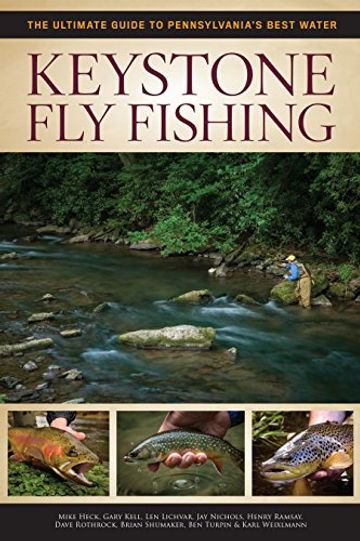Two Books that Belong on Every Fly Fisher’s Shelf

Pennsylvania Trout Streams and Their Hatches by Charles Meck
Pennsylvania Trout Streams and Their Hatches by Charles Meck
I first got a copy of this when I was 13 years old and it inspired me to no end. I mean, how could a single person have fished so many streams in their lifetime? I was young and it seemed impossible, but knowing someone else had done it made me want to do it, too. And then write about it, of course, like Meck had.
Meck does a great job of delivering both the history of an area and his own personal experience fishing each stream. I love the anecdotes, whether they’re about visiting a stream for the first time, a banner day he had on his favorite fishing hole, or somebody he met along the way. And if his experience with a stream is limited, he relays advice from people who regularly fish there.
Not every Pennsylvania stream is listed in this book, but enough are to keep you occupied for a long, long time. For the most part, Meck left out waters that are considered strictly marginal, put-and-take trout streams. Basically, with few exceptions, if there are no consistent hatches and the water warms up too much to support trout for at least the majority of the year, then it was left out of the book.
There are fairly detailed access maps for many of the streams as well as hatch charts. Readers should keep in mind that this book was written 30 years ago, so a few things might have changed since then in regards to access points, trout stocking, and special regulations sections.
Pennsylvania Trout Steams and Their Hatches was one of the first books I’d ever read that emphasized conservation and catch and release, an idea that troubled me at an age when I enjoyed catching and keeping my limit of stocked trout every time out. I should clarify, though, that wild and holdover trout always received pardon. Even at that age, I recognized their value to an ecosystem.
However, I wasn’t beyond keeping a 20-inch wild brown for my wall – actually, that idea became my obsession and it didn’t let up until I’d caught a 23-inch wild brown and had it mounted. Now that I’m older, I appreciate Meck’s stance on catch and release much more, and it’s even a bit satisfying to release one of those old, monarch browns. Again, I should clarify, I still see nothing wrong with taking a few stockies home for the frying pan, but now I do so in moderation.
Although Meck tries to be as unbiased as possible, it’s easy to tell when he has a passion for a certain stream or waterway. I admire that, and I admire the enthusiasm and hard work that went into this book. It’s a must-read for any fly fisherman.

Keystone Fly Fishing by Mike Heck et al.
Keystone Fly Fishing by Mike Heck et al.
When I got this book in the mail, I couldn’t put it down for at least a week straight, maybe longer. By the time my wife pried it from my hands, I realized I’d grown a beard and my newborn baby was suddenly walking.
This book is a work of art. It’s informative, each waterway written about by someone who knows it intimately, and the photography is amazing. More than anything, this book makes you want to get out and fish. When I flip through this book and view the photos, I literally start salivating. It just about kills me to not spend every second of the rest of my life on the water casting my flies to big wild browns.
Keystone Fly Fishing takes a watershed approach to discussing streams, usually detailing opportunities on both the main bodies of water in an area as well as their most important tributaries. You’ll find a number of streams listed in this book that aren’t mentioned in Charles Meck’s book – although you’ll also find streams in Meck’s book that aren’t written about here. Which is why these are great companion books to own.
Keystone Fly Fishing takes a more comprehensive approach to access points and providing readers with enough information to get them on the water. Sometimes that’s the hardest part of exploring new places, just figuring out where to park, especially with so much posted land nowadays. This book takes all the guesswork out of it. The maps are extremely detailed and up-to-date. You can take their guidance to the (stream) bank.
Although this book is written by multiple authors, the text is cohesive in tone and style. The advantage of having a book like this by multiple authors is that each of them write in relation to their individual expertise. Each of them is writing about the places they know best, and they offer plenty of insights to help you achieve success on any stream you decide to explore.
One of the fringe benefits of owning this book are the photographs of some 240 fly patterns the authors have used while fishing the places they’re writing about. Some of the patterns are unique to certain regions of the state, which lends a local flavor to the work that I appreciate.
Above all, the writing in Keystone Fly Fishing is honest. What you read in this book is what you can expect to find when you travel to that destination, whether it’s hatches or quality of the fishing, and all fishermen who purchase a copy will appreciate that.
Sign up for the Dark Skies Fly Fishing e-newsletter
It's free, delivered to your inbox approximately three times each month. Your information is always kept private and used for the sole purpose of keeping you up to date on blog posts and specials in the online store.
Sign Up Now